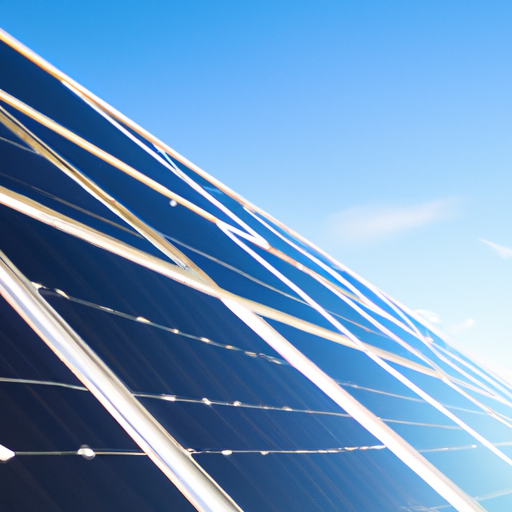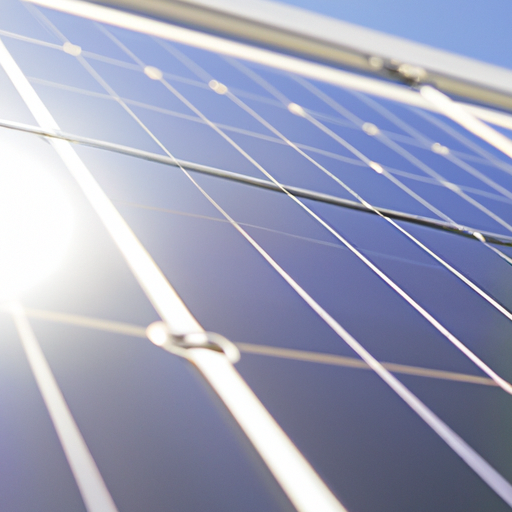

So you’re interested in learning about how to store solar energy for the long term? Well, you’ve come to the right place! In this article, we’re going to dive deep into the best practices for storing solar energy in energy storage systems. Whether you’re a homeowner looking to harness the power of the sun or a business owner wanting to reduce your carbon footprint, understanding how to store solar energy efficiently is key.
When it comes to storing solar energy, there are a few methods that are commonly used. One popular option is to use batteries, specifically rechargeable batteries, to store the energy generated by solar panels. These batteries can then be used to power your home or office when the sun isn’t shining, such as during the nighttime or on cloudy days. Another method involves converting the solar energy into hydrogen, which can then be stored and used as a fuel source. This method is particularly useful for larger-scale energy storage systems.
In this article, we’ll explore the different types of batteries used in energy storage systems, the pros and cons of each method, and some tips for maximizing the efficiency of your solar energy storage. So if you’re curious about how to make the most of your solar power system, keep reading! We’ve got all the information you need to become a pro at storing solar energy for the long term. Solar energy has become an increasingly popular source of renewable energy in recent years. With advancements in technology, the efficiency and affordability of solar panels has improved, making it more accessible for homeowners and businesses alike. However, one challenge with solar energy is its intermittent nature. The sun doesn’t shine 24/7, and energy needs to be stored for use during cloudy days or at night. This is where energy storage systems come into play.


Importance of Storing Solar Energy
Advantages of Solar Energy Storage
Energy storage systems allow excess solar energy to be stored for future use, ensuring a reliable and continuous supply of electricity. By storing solar energy, users can enjoy the benefits of solar power even when the sun isn’t shining. This is particularly important for off-grid locations or during power outages.
Storing solar energy also helps address one of the main challenges of renewable energy sources: their intermittent nature. By storing excess energy, it can be used during peak demand periods or when renewable energy generation is low. This helps reduce reliance on fossil fuels and promotes a more sustainable and resilient energy grid.
Need for Long-term Storing of Solar Energy
While short-term energy storage can help balance the supply and demand of electricity on a daily basis, long-term energy storage is vital for ensuring the stability of the energy grid and for supporting the transition to a renewable energy future.
Long-term storage allows solar energy to be stored for weeks, months, or even years. This is particularly important when considering the seasonal variations in solar energy generation. During the summer months, when solar energy production is at its peak, excess energy can be stored for use during winter when solar energy production may be limited.
In addition, long-term storage is essential for addressing the intermittency and variability of renewable energy sources. This ensures a consistent and reliable power supply, reducing the need for backup fossil fuel power plants and maximizing the utilization of renewable energy.
Types of Energy Storage Systems
There are several types of energy storage systems that can be used to store solar energy for long-term use. Each system has its own advantages and considerations, and the choice of system depends on various factors including cost, scalability, and environmental impact.
Battery Storage Systems
Batteries are the most common and widely used energy storage systems for solar energy. They allow electricity generated by solar panels to be stored in chemical form and converted back into electrical energy when needed.
Lithium-ion Batteries
Lithium-ion batteries are the most popular and commonly used batteries for solar energy storage. They are known for their high energy density, long life span, and high efficiency. Additionally, lithium-ion batteries have a low self-discharge rate, meaning that they can retain stored energy for long periods of time without significant loss.
Flow Batteries
Flow batteries are another type of battery storage system that can be used for long-term solar energy storage. Flow batteries store energy in chemical electrolytes and can be charged and discharged repeatedly without degrading their performance. They have a long cycle life and can provide a large amount of energy storage capacity.
Solid-State Batteries
Solid-state batteries are an emerging technology in energy storage. They use solid electrolytes instead of liquid electrolytes, which improves safety and energy density. Solid-state batteries have the potential to offer higher storage capacity and longer lifespan compared to traditional lithium-ion batteries.
Pumped Hydro Storage
Pumped hydro storage is one of the oldest and most established forms of energy storage. It utilizes gravity and water to store energy. During periods of excess solar energy, water is pumped from a lower reservoir to an upper reservoir. When electricity is needed, the stored water is released, flowing down to generate electricity through turbines.
Pumped hydro storage has several advantages, including its high energy efficiency, scalability, and long cycle life. However, it requires suitable geographic conditions and large-scale infrastructure, making it less suitable for smaller-scale applications.
Compressed Air Energy Storage
Compressed air energy storage (CAES) is a method of storing energy by compressing air and storing it in underground caverns or tanks. During periods of excess solar energy, air is compressed using electricity. When energy is needed, the compressed air is expanded and used to drive turbines, generating electricity.
CAES has the advantage of long-term storage capabilities and relatively low upfront costs compared to other storage technologies. However, it faces challenges in terms of energy efficiency and the environmental impact of releasing compressed air.
Flywheel Energy Storage
Flywheel energy storage systems store energy in the form of kinetic energy. When excess solar energy is available, a motor accelerates a flywheel to store energy. When electricity is needed, the kinetic energy of the flywheel is converted back into electrical energy.
Flywheel energy storage has advantages in terms of fast response times and high power output. It also has a long lifespan and can be easily scaled up or down. However, it has limitations in terms of energy storage duration, making it more suitable for short-term energy storage applications.


Factors to Consider for Long-term Energy Storage
When choosing an energy storage system for long-term solar energy storage, several factors need to be considered. These factors include capacity and scalability, efficiency and round-trip losses, durability and longevity, and safety and environmental impact.
Capacity and Scalability
The capacity of an energy storage system refers to the amount of energy it can store. It is important to choose a system that can meet your energy needs and is scalable to accommodate future expansions or increases in energy demand. Considerations should also be given to the rate at which the energy can be discharged from the storage system.
Efficiency and Round-trip Losses
Energy storage systems have round-trip efficiency, which refers to the efficiency of storing and retrieving energy from the system. It is important to choose a system with high round-trip efficiency to minimize energy losses during the storage and retrieval process.
Durability and Longevity
Energy storage systems should be durable and have a long lifespan to ensure optimal performance and return on investment. Consider factors such as the lifespan of the system, maintenance requirements, and warranties.
Safety and Environmental Impact
Safety is a crucial consideration when choosing an energy storage system. Ensure that the system meets the necessary safety standards and has appropriate safety features. Also, consider the environmental impact of the system, including the materials used in its construction, recycling options, and any potential emissions during operation.
Integration of Energy Storage Systems
To fully maximize the benefits of solar energy storage, it is important to integrate energy storage systems into the existing energy grid. This allows for better utilization of renewable energy sources and improved grid stability.
Grid Integration
Grid integration refers to the connection of energy storage systems to the electrical grid. It involves managing the flow of electricity between the storage system and the grid, ensuring a smooth and stable energy supply. Grid integration also enables the energy storage system to provide grid services such as frequency regulation and peak shaving.
Microgrid Applications
Microgrids are small-scale energy systems that can operate independently or in conjunction with the main electrical grid. Energy storage systems can be integrated into microgrids to provide backup power during outages or to support renewable energy generation. This allows for increased energy self-sufficiency and resilience in areas with unreliable or expensive grid access.
Optimizing Solar Energy Storage
To optimize the storage of solar energy in energy storage systems, several strategies can be employed.
Smart Charge and Discharge Strategies
Implementing smart charge and discharge strategies involves optimizing the timing and rate at which energy is stored and released from the system. This can be done by considering factors such as energy prices, peak demand periods, and weather conditions. By optimizing the charge and discharge cycles, the overall efficiency and performance of the storage system can be improved.
Sizing and Balancing Systems
Sizing and balancing an energy storage system involves determining the optimal capacity and configuration of the system to match energy supply and demand. This includes considering factors such as the size of the solar panel array, energy consumption patterns, and the desired amount of energy independence. Proper sizing and balancing help ensure that the system can meet energy demands while avoiding over or underutilization of the storage capacity.
Predictive Analytics
Predictive analytics involves using data and algorithms to forecast energy usage patterns and optimize energy storage operations. By analyzing historical and real-time data, predictive analytics can provide insights into energy consumption trends and help optimize the operation of energy storage systems. This can result in improved performance, increased efficiency, and reduced costs.
Conclusion
In conclusion, storing solar energy for long-term use is crucial for maximizing the benefits of solar power and transitioning to a renewable energy future. With the advancements in energy storage technologies, there are now various options available for long-term solar energy storage, including battery storage systems, pumped hydro storage, compressed air energy storage, and flywheel energy storage.
When choosing an energy storage system, factors such as capacity, scalability, efficiency, durability, safety, and environmental impact should be considered. Integrating energy storage systems into the existing energy grid, whether through grid integration or microgrid applications, can further enhance the benefits of solar energy storage.
To optimize solar energy storage, strategies such as smart charge and discharge strategies, sizing and balancing systems, and predictive analytics can be employed. By considering these best practices and advancements in solar energy storage, we can ensure a more reliable, sustainable, and efficient energy grid powered by solar energy.



